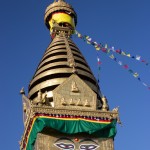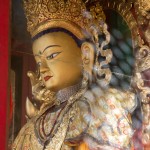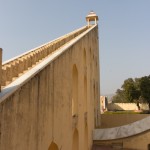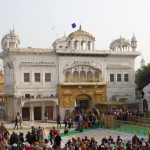Today we were told about a cave system which lay one and a half hours walk from Bandipur. We fancied a walk and felt the need to get some practice in before attempting a trek in the Himalayas to the north.
Before we set off we said farewell to Eiji who was headed to Pokhara, and we filled up on toast and porridge which put us in good stead for the afternoon.
What I wasn’t expecting was just how far we would have to walk today. The journey started off fine. We left the village and walked up to the outskirts which overlooked the large valley which separated us from the great mountain range. We stopped in awe off the sight.
Below us, stood some distant towns and a winding river that threaded through the valley. Beyond them, the Himalayas stood tall and proud.
We found a sign by the side of the cliff which showed the way to the cave. It pointed down a steep staircase that ran down into the dense foliage, and we set off. The path wound back and forth and plunged ever further down.
We passed a trio of Nepalese ladies with giant bushes strapped to their backs, which they lugged back up the hill to the village. They all beamed us wide smiles as they passed and greeted us in the Nepalese fashion with an enigmatic “Namaste”.
The path became steeper and steeper and the flat stone steps turned into loose gravel and rocks. A little further down we encountered a lady looking after three cows which were feasting on the grass verge. Each cow had a large cow-bell (the first time I’ve actually seen this) and they clanged loudly as we walked on by. All this time I was looking back at the road we had come down and worrying how we were going to get back up.
We walked for about two hours down the side of the large ridge, stopping occasionally for a breather and some water. Adam led the march, really setting the pace, and by the time we got to the cave entrance at the bottom we were all feeling pretty wobbly. Our legs had turned to jelly and we kept our newly acquired cave guide waiting, as we recovered enough strength to carry on.
The cave was the largest in Nepal, and soon we were climbing down ladders and steadying ourselves on tethered ropes as we descended further into the dark, dank, subterranean pit. At one point we all turned off our torches and fell silent. The silence was oppressive in the Stygian darkness and we soon turned them back on again to avoid the sensory deprivation. Large calcite deposits fell as petrified waterfalls, and up above us metal or crystal deposits glittered in the rock.
Finally we emerged into the daylight, and brushing off the dust from the cave, looked up at the savage climb.
We kept up a good pace and give it our all as we climbed back up the steep bluff. The ascent took us the good part of an hour and a half, and we were overjoyed to make it to the top with the last of our energy fleeting. I caught a great victory pose from Adam and Nicole which you can see below.







































